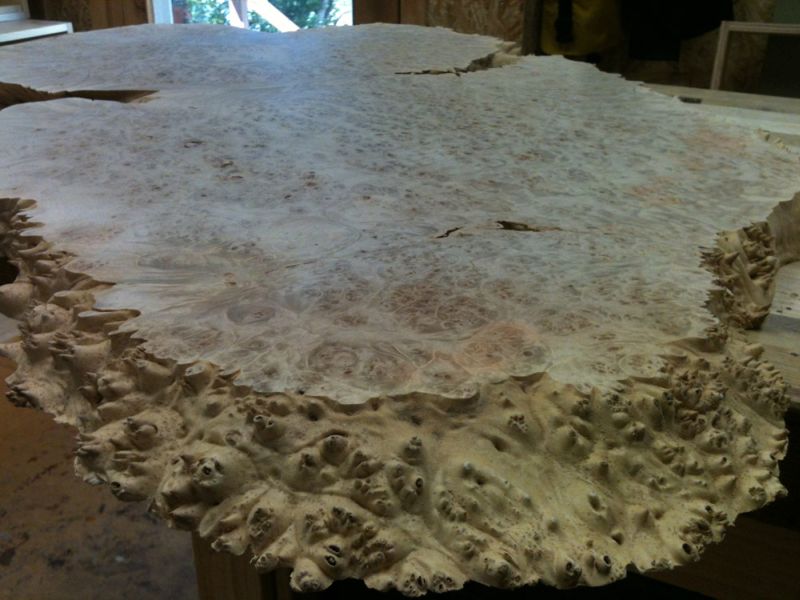Has Buried Metal Ever Ruined Your Day?
Bicycle sprockets, unexploded ordinance ... you never know what you're going to find in a tree. Here are the tales of buried metal contributed by Woodweb members competing to win a metal detector. The contest is over, but the stories (like spikes in a tree) last forever. April 15, 2013
Editor's Note: This forum discussion originated as a giveaway for the Lumber Wizard 4 metal detector. The giveaway has ended, but we hope you'll still share the story of your ruined day by clicking the "add information" link at the bottom.
Question
From the Staff at WOODWEB:
Has buried metal in a log or piece of wood ever ruined your day? If so, tell us your story, and become eligible to win a new Lumber Wizard 4 metal detector from Wizard Industries.
Two winners from this Forum will be chosen, and both will receive a free Lumber Wizard 4. The Lumber Wizard 4, manufactured by Wizard Industries, is a precision metal detector for locating nails, screws and other metal inside new and recycled wood, and pinpoints the exact location of metal. It works on all types of woods, particle board and solid woods.
Forum Responses
(Solid Wood Machining Forum)
From contributor A:
My favorite story is about a pecan tree I lumbered. It came from a home in town so you might expect nails, rope, wire, and other stuff. I didn't get any of that but what I did get was several bullet slugs buried deep inside. They became very visible as their shining cores said hello in my fresh lumber.
From contributor B:
The first log that I sawed into lumber back in the early days of my woodworking was a 28" dead walnut that grew beside a highway. After a year of air drying, I was anxious to start using it and as I planed my first board, I saw that I had planed through some nails and really messed up my blades. I examined them and found nothing wrong, so I took a better look at the "nails." They were in fact bullets. I cut out a section of that board, framed it and it hung it on the wall of my insurance office as a conversation starter until I retired. Now it is in my office at home. Who but a woodworker is crazy enough to frame a piece of wood?
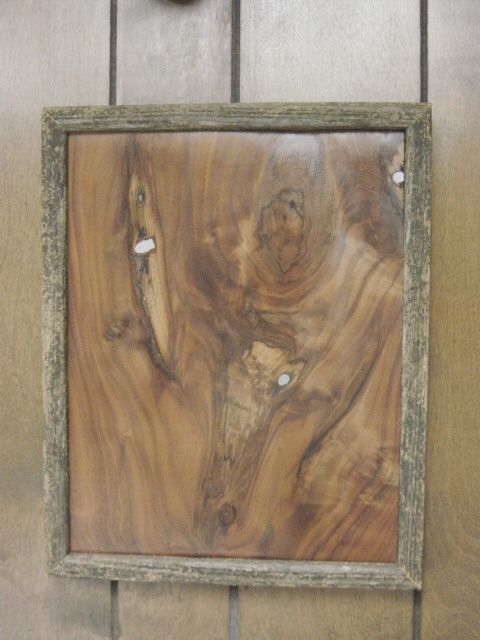
Click here for higher quality, full size image
From contributor K:
Two years ago I was asked to remove a box elder tree. Just a couple of small branches on a 42 by 12' trunk. The ants and rot were busy inside. There was just enough rot inside that the 18 saw was enough.
The tree was in an old part of the city of Anoka and I wondered how many children had played in the 100 + years tree. With no equipment to move the logs, I decided to cut it to bowl blanks on site. 14 x 14 of bark and about 14 deep. When I found a nail I would stay in the kerf and go around it. Cut the top half of the log, roll the log. Now, where were those nails? Of course several sharpenings. The story does have a happy ending though. This is what I turned out of the first blank, and it did have a nail in it. I am waiting for the Wizard before turning the rest of them.
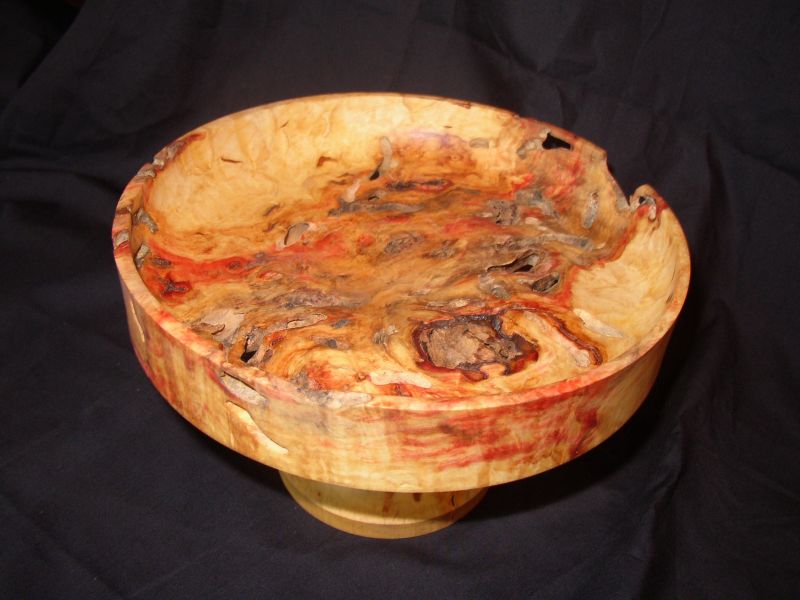
Click here for higher quality, full size image

Click here for higher quality, full size image
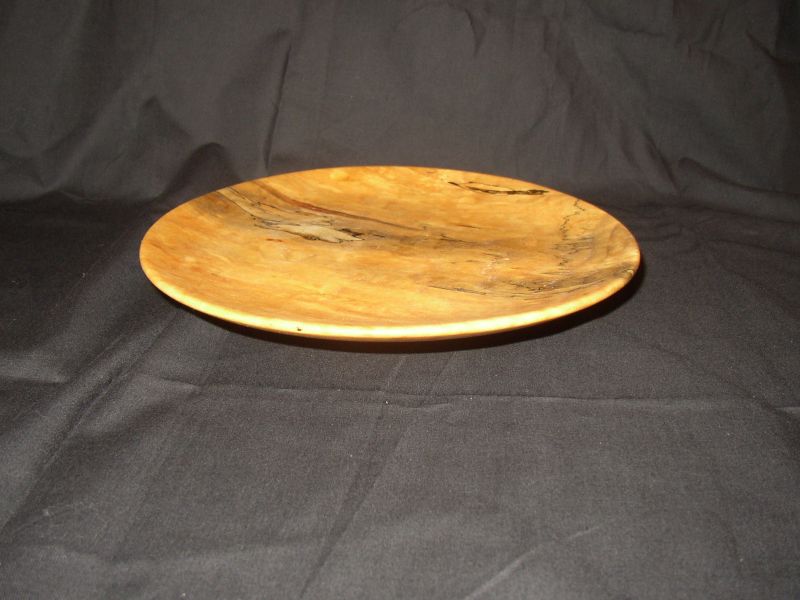
Click here for higher quality, full size image
From contributor R:
A few years ago I was milling a log when the blade broke. Checking the log, I found a bullet in it. So I took a deep cut, made some firewood out of it. Sometime later a log from the same area caused the same problem. This happened a third time. It turns out that a local gunsmith was using our property to sight his rifles. We are now using that area for firewood only. Even the chainsaw hits a bullet now and then.
From contributor D:
I frequently use recycled wood (read used wood) for shop built jigs and fixtures. But on one occasion I was asked to build a desk from the red oak trims removed from an auditorium. The desk would be seen by everyone because it would be located in the auditorium.
It was beautiful material, dry, and straight. The problem was, unbeknownst to me, all the fasteners had not been removed. The trims, much of which were simply straight milled boards, was put up with an air nailer which buried the heads of the nails and then the holes were neatly filled with matching filler. When they were taken down, the nails were supposedly removed by pulling from the back side. Apparently, some of the workers became impatient with the job and just broke the nail shanks off even with the back surface.
There was a boatload of the stuff and I was careful to select the nicest looking boards for the desk. There were no wide boards on the lot, so I would have to edge glue pieces where I needed wider stock.
Every board that needed jointing was done on the tablesaw equipped with a newly sharpened carbide fine tooth blade. The glue lines were all but invisible. I was feeling very good about myself. But these were the days before I had a metal detector.
A number of times, after ripping a nice long board, I saw the glint of metal on the bright, clean edge. Fortunately, the nails were a small gauge, small headed type and didn't knock out teeth from my fairly expensive blade, but before it was all over, that blade had to go back to the shop for another treatment.
The desk turned out beautifully. But I could have built that desk in half the time had I not had to excavate hidden nails. I now go over all my stock, even new stuff, with a metal detector. I have found metal even in newly milled material. Here's a photo before the finish was applied.
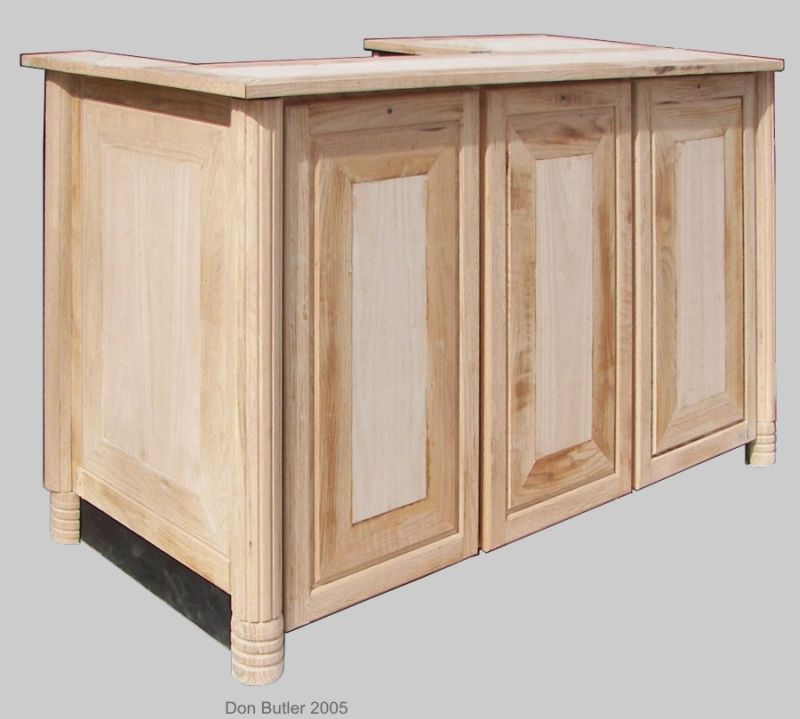
Click here for higher quality, full size image
From contributor J:
A few years ago I was going to save money by planing my own hardwood for a coffee table. This was my first attempt at planing with my new DeWalt out-of-the-box planer. I was so proud to be able to make my own lumber. I started up the planer and ran first board in, and bingo - I hit an unexposed staple and the rest is history. I had to remove blades and get sharpened. So now I have about $400.00 invested in a board and no table to show for it. Now I almost refuse to use pallet wood unless I can see staples.
From contributor I:
I cleared a lot for an office building. I felled a 80 year old oak tree with a long, straight bole and took it to a sawmill in Julian, CA. The six foot blade had carbide teeth. Sure enough, it hit a nail buried about two feet into the log and broke a couple of teeth. That cost me $$ since the sawyer told me that any damaged teeth would be my cost.
From contributor Y:
It was March of 1998 and I had finally managed (somehow!) to purchase a nearly-new Wood-Mizer portable sawmill. It was a one-year-old LT40 Super Hydraulic and I couldn't wait to saw my first log - solo. So I got it set up and rolled a big red oak log up onto the loading arms and got the massive piece of timber in place and ready to saw. Double-checked all the settings and I was off! My blade entered the log... and then it just dove straight down. I mean straight... down. I couldn't believe it. I had done fine when sawing under the tutelage of the previous owner. Now it was amateur hour or something like it. I thought to myself that I'd change blades and see if it made any difference. I got perhaps another three inches and once again - straight down went the blade.
I backed it out and started looking into the cuts I had just made for some clues as to what was going on. Then I saw it. Not two inches from the end of the log was a half-inch diameter lag bolt! It was an old log so if there was any blue staining on the end it wasn't visible. And since it was my first time I didn't know to listen for that expensive high-pitched sound that sawing through a half-inch(!) diameter steel bolt will make. And in case you're wondering - no, the bolt head wasn't visible from the outside of the log! Anyway, I sawed the end of the log away and gingerly tried again with yet another new blade. It worked this time and I've been running blades through logs ever since! That wasn't the last piece of steel I've sawed through in my days as a sawyer. It is, however, the only one I've sawed through twice!
This picture is of a big walnut log that had some nails in it. It was worth the trouble as it was a large, high-grade log.
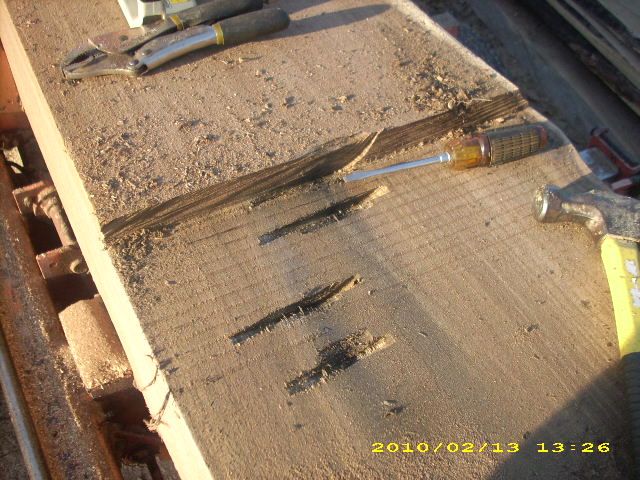
Click here for higher quality, full size image
From contributor S:
Received a beautiful 27" white oak to saw. It looked flawless! The first few cuts harvested beautiful clear boards which made me very happy. But as fate should have it, the next cut I hit a solid piece of metal, 1/3 of the way in the tree. After much investigation (along with two hours of prying a broken blade out of the middle of the log) we found a hook that supported an old washline that must have been put in many years ago when the tree was a third its size. The wood then had a bluish tint throughout. No evidence was seen prior to sawing.
From contributor V:
Bought a new hollow core door from a lumberyard in Hollywood, Fl. Took it a short distance to a local cabinet shop that would joint about 1/8th-3/16th off the bevel edge to help me fit the existing opening. After one pass with no problem, the next cut hit a lead bullet embedded in the fir frame. All 3 knives were pretty well ruined. A resharpening cost and loss of steel for $5.00 made the day a loser for the shop. This was 1965, but the good disposition of the cabinetmaker after such a setback is still found today.
Another instance I know of is missing fingertips on the right hand of an employee that hit a live bullet when ripping a piece of hardwood.
From contributor O:
I have ruined several table saw blades and several band saw blades and one very expensive router bit due to hidden metal. One day I hope to own a Wizard metal detector.
From contributor M:
The story I'm going to tell goes back to 1980 when for the first and last time (as my wife later insisted) I actually logged about 30 black walnut trees on the western slope of the Otonabee River close to Rice Lake in Ontario, Canada.
The walnut grove that the owner insisted be logged was on about a 30 degree slope where a small access road traversed back and forth from the top of the rise to his cottage/fishing camp at the river bottom. And while no other professional loggers would buy these trees I, as an aspiring woodworker, thought I had struck gold.
The actual felling of the trees went fairly easily and the slope was an advantage as I was able to use a come-along, gravity and determination to haul each log cut down to the access road at several points where a lumber truck was contracted to haul them to the local sawmill about five miles away.
And here was where my encounter and near death experience with buried metal occurred.
As with everything I like to take a hands on approach to everything I do. As a result, while the old sawyer on a vintage outdoor roofed circular mill cut the logs into lumber for me, per my specifications, I manned the tail board with his helper stacking the planks.
Everything was going great for about an hour or so and I was marveling at my good fortune in logging the trees and thinking about the projects I could make with the three or four thousand board feet of lumber that were being produced.
That is when in a micro-second several things happened at once. The first thing was that, even though the sun was shining, I heard the sound of rain drops on the tin roof which covered the circular mill. The second thing was I heard what I thought were angry bees going by my head. The third was (to my amazement) both the sawyer to my right and his helper to my left had collapsed on the ground.
Of course it was only as the 52" saw blade ground to a halt and I asked what happened that I, the greenhorn, learned that we had struck something metal in the log. And just like pellets from a shotgun, both the sawyer and helper had hit the deck to avoid this shrapnel. I, oblivious to the danger, had just stood there unwittingly facing injury or death.
To this day I still have the small section of walnut log where the 3/4 inch metal bolt we had hit was neatly sawn in two. As it turns out the spike had been driven into the tree many years previous when they first ran hydro to the old hunt camp through the trees.
So if anyone wonders why they can't get a tree from a hedgerow or backyard sawn at the local mill, the answer is that someone could get killed if the carbide tipped blade hits metal, and the effort and price of replacing the carbide teeth on a 52" circular saw blade simply isn't worth it.
Of course, this story happened before the Lumber Wizard 4 was invented and, if my cautionary tale is chosen as one of the winners, I'd love to own one to use.
From contributor Q:
I was working at a crib manufacturer. We would insert a 3/8" cross dowel into the ends of the rail pieces. If the piece was rejected for use we would chop the ends off with the cross dowel and rip the remainder into a smaller width cleat. This day another person was cutting the ends with the cross dowels off and I was ripping the remaining down. Suddenly just below my belt I felt a very sharp pain. Because of how quickly and sharp the pain was I knew I had been shot. The shock almost put me on my knees. Moments later after most of the others in the area had come over to see what had happened I checked to see my wound. I discovered that a cross dowel had been missed. The 16" blade on the table saw I was using hit it and threw it back so quickly that the cross dowel had barely broken the skin. Of course it was days before I was walking easily.
From contributor U:
I was given a beam from a home remodel made of two 2x12s with 1/2" ply in between. The 2x12s had nice grain and I thought I could use them in the shop for something. I tore the beam apart, removed all the spikes and was running the first piece through the tablesaw. I suddenly felt a sharp burning sensation in my chest. I opened my shirt and found a perfect imprint of a partially bent 16ga finish nail. On the floor laid the nail. Had that nail not landed perfectly flat
!
From contributor P:
Two recent unusual finds; one we knew about, the second not.
1. We sawed an urban red elm - magnificent tree, but with an old 1" auger bit embedded and grown over about 14' up on the tree. Of course this same tree also had about 2 bags of sac-crete encased and grown over - and yet I still call it a magnificent tree?
2. While cutting down a 50"dbh bur oak we were told there is a 6" steel pulley in there somewhere - the old clothesline pulley that the now 54 year old son remembers they used to ride on from back porch to tree. We just grazed the edge with a chainsaw and will now be making it into a table - pulley included.
From contributor X:
One day I was custom cutting a huge black walnut. It was the end of the day and we had finally gotten the thing square and were making good progress... Then we hit a nail and ruined a blade. Remove nail, replace blade, hit another nail. Remove, replace, repeat. This happened four times and we ran out of light and had to come back to the job and chew up a whole other day. The worst part? I had forgotten to quote that ruined blades were extra...
From contributor W:
Was sawing a large walnut log and hit metal approximately 1/2 inch in diameter. Customer stated that he had broken 2 pry bars trying to get the metal out, so he just left it in and didn't tell me it was in there. Changed the blade, chiseled out around the shank, snapped a pair of vise grip pliers around the shank and unscrewed a 4 inch long lag bolt. Do I have a metal detector? Sure do - it cost about $30,000.00 and tows behind my pickup. If metal is in there - it'll find it.
From contributor E:
So it's one of those days where we have an order to get out, like many others in this industry, we find that either the wood we need is coming in too slow due to the weather, or something else happens that slows production.
On this particular day we find ourselves with a double whammy. A nice 20" pine log goes through our saw, as we cut the edges down, the first pass, slab heads to the chipper, second pass the slab is headed to the chipper and on that third pass, we hit metal. You know that unmistakable sound of the blade breaking like a tight spring being released from a vice.
The mill stops and our guys hustle to change that blade. Keep in mind those two slabs are still heading to that chipper. Now, need I remind you - that chipper is made for chipping wood.
Seems the second pass on that log missed a nice piece of metal. It must of been 'cause when that chipper started to chip away, that piece of metal blew through the blades, and out through the wall of the chipper like a missile. Destroyed the knives, locked up some of the mechanisms and blew a huge hole through the side of the chipper walls, ruining it to the point we had to replace the whole machine.
Piece of wood, $28 Saw blade, $10 wages, $360, chipper $28,000. Lesson learned - priceless... That's why a person needs a Lumber Wizard 4 metal detector.
From contributor Z:
I saw our own lumber with a bandsaw mill for use on the family farm. If I had the means, I would do more custom sawing and turn it into a part time business. I was sawing a tree from the property which was a large white poplar, and heard the blade slice though something that didn't sound quite right. After investigating, I found an area in the log and the boards that I was about to saw that had a purplish stain in it and finally saw what I had hit. It was several copper jacketed bullets that had been shot into the tree. If I had checked the tree with a metal detector, I would have found where they were and not sawed through them.
From contributor C:
Much of the wood I get to make my bowls comes from local farmland. I often find a nail from a sign or maybe some barbed wire, but this caught me off guard. Completely embedded was a 5/8 x 12 bolt. Needless to say the chain was toast!
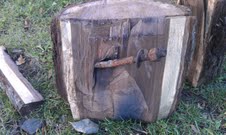
From contributor N:
My neighbor was milling several species for his shop and I had some beautiful Western red cedar logs I wanted to mill. I assisted him for several hours before we got to my logs. There was no bark on them and I did a visual inspection, but didn't (the very last time I didn't) scan with my metal detector. About six feet down the length of the first log there was a racket that would wake the dead, sparks flew briefly, and the bandsaw blade flew off the wheels as my neighbor shut down the mill as quickly as he could. Even with his incredibly quick reaction, I was now the not-so-proud owner of a blade in serious need of sharpening. After profuse apologies and a new blade installed, and my logs tossed aside for further metal removal, I went home and started setting up the bandsaw sharpener which he had given me to tinker with and start sharpening blades. Luckily for me, he had done this himself before, and was not as upset as he might have been. I, on the other hand, was rather ticked off at myself. I now have two metal detectors, one always within reach of any logs or salvaged lumber.
From contributor G:
I was cutting 11 ft. long x 35 in. wide mango wood slabs on my Peterson sawmill when I discovered two metal fence wires running about two inches apart from each other through each 2 1/4 in. slab that I was cutting. Very depressing and aggravating, considering each slab was curly and had nice color grain. Had to stop and resharpen my chain sawmill and dig out each metal wire on each slab.
From contributor V:
I was cutting a small piece of plywood about 6 inches by 18 inches from one of the big box stores when I hit a large piece of metal and had the plywood kick back and tear my palm open. I had to get 11 stitches one week before my son's wedding. The plywood was supposed to be part of the center piece on the gift table. I have had other pieces of metal in wood before but not as big as this piece was.
From contributor H:
Was cutting some crotch wood and getting close to the middle and my Wood Wizard beeped, so I turned the wood over and sawed till I got close to the middle again. I cut off the crotch and split the two foot piece and found a Black and Decker little three tooth battery trimmer. I ask the farmer about it and he said it was lost 40 years ago.
From contributor T:
I was thrilled at the black walnut log that was given to me, as you might imagine. I was planning to cut the log in half, then saw up the halves. The first cut into the log took all of the teeth off my bandsaw blade. I cut the end of the log off above where I had hit something, and busted it open. I found a chain inside the tree. The links of the chain are of different lengths, so it must have been handmade many years ago. The tree was about 26 inches across. It makes one wonder what the chain was used for. The picture shows the chain with the end of it still embedded into the piece of black walnut log.

Click here for higher quality, full size image
From contributor F:
I had a job sawing white pine for a friend. He was sure there was no metal of any kind in his logs. When I hit the first 2.5 in. masonry nail and broke 7 teeth of my band blade he thought it a fluke and bought the blade. After the second time this happened, he agreed there was a problem, and we stopped sawing the butt logs.
From contributor L:
I was milling a nice maple log about 33" in diameter. Pulling some nice curly maple when about 1/3 of the way into the log I hit a fence. This tree had obviously been used as a corner fence post when it was a lot younger. The wire made a circle around the center 6-8". So in an effort to attain as much lumber as possible, we hit that wire three times when we had thought we had pulled all of it. Two blades needing re-tipping, and too much wasted time.








